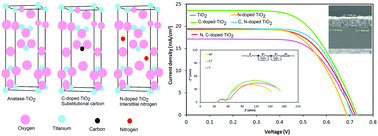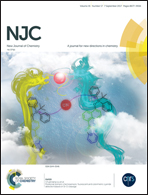Enhanced efficiency of over 10% in dye-sensitized solar cells through C and N single- and co-doped TiO2 single-layer electrodes
Abstract
Herein, we report the impact of single- and co-doping of nanoparticle TiO2 films with carbon and nitrogen on the photovoltaic characteristics of their corresponding dye-sensitized solar cell (DSC) devices. Different DSCs with various compositions of the photoanode electrodes are fabricated to study their structural and electronic properties by X-ray diffraction (XRD), diffuse reflectance spectroscopy (DRS), field-emission scanning electron microscopy (FE-SEM), Brunauer–Emmett–Teller (BET) analysis and X-ray photoelectron spectroscopy (XPS). We find that the interstitial nitrogen atoms for single N doping have a greater impact on the band gap energy (Eg) than the substitutional (to Ti) carbon atoms for single C doping. The short circuit current and efficiency of DSCs are enhanced by C and N single- and co-doping with dominant impression of carbon doping. Furthermore, the electrochemical impedance spectroscopy (EIS) measurements reveal that the electron lifetime, charge transport and recombination resistance of DSCs are improved by C and N single- and co-doping with prominent impact of carbon doping. Therefore, we achieve the highest cell efficiency of 10.2% as a result of a balance between the band gap, surface area, and diffused reflection of the photoanode electrode.



 Please wait while we load your content...
Please wait while we load your content...